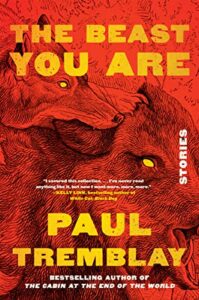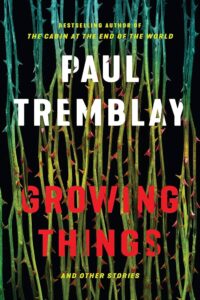
[William Morrow; 2023]
I was once doing a long feature article on new currents in the black metal genre when the front-person of a Maoist Blackened Death band made an interesting point about what had led a band of communist science graduate students into the genre. “Black metal is sort of a template that you can use to get creative with,” he told me, describing the genre more as a texture that you could use to go in wildly different creative directions. There are probably a multitude of reasons for this: the genre’s use of many tracks of dissonant tones allows for a lot of variation, black metal is already built for dissident artistic expression, and, perhaps most importantly, it has a dedicated fan base expecting something different each time.
A similar observation could be made about the horror genre, which is often more financially stable than other types of fiction (and particularly in the world of horror film) since the audience is sustained by die-hards who are willing to go in just about any direction an author will take them as long as it is sufficiently terrifying. This is why you see so many independent filmmakers using horror as a tool to explore complicated themes, only to lighten up on their genre commitments later in life (David Cronenberg seems the archetypal example). But if we look at modern horror fiction, what is accepted by genre faithfuls today is often expansive: As long as you can make it scary, just about anything goes. And with the increasing presence of literary horror, the ability to craft an intellectually stimulating, emotive, and captivating story through horror conventions is itself a triumph. If you can invent something new, and do it openly and honestly, you deserve commendation. But if you can somehow work a Lovecraftian monster into the same tract? That’s Einstein level.
This is sort of how I think about the work of Paul Tremblay, which seems anchored to the horror world, yet steps out of it just as often as the work plays into the tropes. Tremblay’s best-known book is The Cabin at the End of the World, recently made into the satisfactory M. Night Shyamalan movie Knock at the Cabin. The book starts with an absurd premise involving compulsive murder and a possible End of Days. But it is really about the pressure of relationships, how our memories never leave the front of our minds, and what it means to hold love and use it to build a family despite the trauma encroaching on us from all sides. The film adaptation betrays the underlying unsteadiness of the novel by resolving it in ways that seem to run counter to Tremblay’s most basic creative impulses, but there are worse crimes.
Tremblay’s most recent novel, The Pallbearer’s Club, moves in and out of horror in such a perfect way that the balance itself may end up as the book’s defining feature. The story is largely about how to view a life that fails to go according to the plan, and the question of whether something gruesome lies just off the page so long in the book that, in the end, we probably never needed it in the first place (but are happy to have it). For Tremblay, horror is the starting point, the texture he paints on, and whether or not he needs that terrifying edge, it’s not really the reason the audience sticks around till the last page.

I thought about this dynamic when reading his most recent book, The Beast You Are, a collection of short stories (and one novella), most of which had been published before. I had my eye out for this book because it was his short stories that first alerted me to Tremblay, particularly his earlier collection Growing Things. That book contains some of the more genuinely frightening stories I’ve ever read, each building tension on an almost excruciating amount of subtlety. Tremblay is not known for painting you a clear picture of what exactly is wrong in the world he is building (a character in The Beast You Are jokes about this). But, as with his entire canon, don’t let the details distract you from the point. Short fiction is its own country in the horror world, dominated by a key line-up of authors, editors, and publications. As a result, the rules are more restrictive. You have less time to pull off a grand narrative feat, so you have to keep it simple: basic characters, uncontested plots, and clear, identifiable scares. This is a tall order for Tremblay, who must try to stamp his brand of ambiguity onto a format that demands precision. These interventions come nestled in shockingly beautiful wordplay, descriptions that bathe the reader in the story’s world and that convey the same uneasiness, melancholy, and wonder the characters are experiencing.
The book has some unevenness, partially because it lacks a centralized theme. These limitations are particularly noticeable in its reliance on ultra-short pieces that feel a little more forgettable. When it comes to work whose length is nearing microfiction, the standard model is to use some kind of campy device or well-worn cliche and then to break up that monotony by introducing a single novel idea or intervention. This can sometimes work, but it rarely draws in readers coming for entrancing narratives. The fact that several stories read this way is less the fault of Tremblay and more the limitations of the structure, and his approach to these quick pieces is often more exciting than you would usually experience. But it also feels like a clean-up effort, where Tremblay is pulling everything and anything he has written so he can pad out the book. “I Know You’re There” is an example of this, whereby the device is eclipsed by the embedded grief, allowing it to perfectly capture a single emotion without filler or excision.
But just because there are pieces that might garner less attention, don’t let it distract from the fact that there are more standout stories in The Beast You Are than you will typically find in any one book. The collection starts out incredibly strong with “Ice Cold Lemonade 25 Haunted House Tour: 1 Per Person,” a dynamite story from last year that was good enough to lead off Ellen Datlow’s Best Horror of the Year Volume Twelve collection for 2020. The book also ends on “The Party,” another great story that was included in Datlow’s celebration of Shirley Jackson, one whose haunting simplicity stuck with me for weeks.
Two stories in The Beast You Are were particularly notable because this was the first time I came across them. The first is “The Blog at the End of the World,” told as a series of blog entries revealed in reverse chronology, where an average person debates whether they are seeing a pattern that betrays an incoming pandemic. The isolation of the COVID-19 pandemic peak, the centrality of online communication during social distancing, and the profound loss that accompanied almost every person’s story gave Tremblay’s piece a sharp edge, but what really provided its ghostly quality was the sense of doubt provided by commentators. We are increasingly living in a space of contested narratives, a vanishing consensus reality that has been replaced with constant gaslighting about the crisis we are living in.
Similarly, “The Last Conversation” also utilizes a pandemic, in this case one that has eradicated most of the planet’s population except for a few unlucky people who have complete immunity. The story unravels into a devastating repetition of grief, one that was crushing enough that I put the book down for the rest of the weekend (this was my Shabbos read, after all). All these stories play fast and loose with the concept of horror, yet none of them abandon it entirely. Instead, genre is a way in, all while expanding our conception of genre fiction.
The biggest problem with The Beast You Are, however, is not in the quality of its short fiction, but in the book’s namesake. The volume ends with a novella of the same name that is really more of an epic poem. It takes up almost half the book’s length and is essentially an incredibly long-winded fairytale. Personally, the use of these types of folk tales, which immediately undermine literal world building in the story space, have never been my favorite because I find it difficult to connect to the rendering in the way I easily do with relatable characters (difficult, but not impossible). I suspect more people will share my reservations than don’t, so the story feels like an incredibly well-written but narrowly niche type of experiment. The question I have is less why the novella was published—I’m sure there is an audience that will find this incredibly intriguing—but why it had to be attached to the other stories. The rest of the book would have been a little short, but by no means too thin. Instead, releasing the novella on its own would have ensured that it cultivated a particular audience that would fit its particularities. It reminded me of a short book by Adam Nevill, Wyrd and Other Derelictions, which, while very different (it is an experimental series of stories that have no characters in them), existed as a type of fringe fan favorite. It would have made sense to separate this book into two volumes, thus ensuring each audience gets what it’s looking for.
There is no reason not to recommend The Beast You Are, or other books from Tremblay’s library. His beautiful prose style and commitment to stretching genre storytelling has impacted the entire market. There are stories in The Beast You Are that are worth the entire book price. I am looking forward to what he does next, and despite that the book’s namesake did not fit my personal tastes well, it was a testament to his interest in growing as a creator. Let’s hope he takes the rest of the horror world with him.
Shane Burley is the author of Why We Fight: Essays on Fascism, Resistance and Surviving the Apocalypse (AK Press, 2022), among several other nonfiction books. He contributes to places such as NBC News, Al Jazeera, MSNBC, The Independent, The Baffler, Oregon Humanities, Jewish Currents, Jacobin, The Daily Beast, and Bandcamp Daily.
This post may contain affiliate links.







